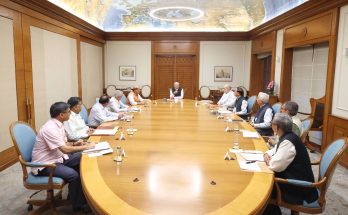 The Indian Ocean Region is witnessing an unprecedented flux in its security complexion. A flurry of recent events in the region, which has both regional and global implications, has created an additional dynamic in the region. In spite of strong warnings from India’s National Security Advisor Ajit Doval, a Chinese submarine, Changzheng 2 was docked at Colombo, along with warship Chang Xing Dao. This incident has geopolitical implications and portends to China’s growing naval profile in the region. Sinking of a naval vessel off Vishakhapatnam and the loss of life of the Navy personnel and seaports in Kolkata receiving a series of intelligence warnings of an attack are few of the recent events that underlines myriad complexities of maritime security. These events underscore the importance of maritime security and throw light to the varied aspects of maritime security challenges that needs to be addressed.
The Indian Ocean Region is witnessing an unprecedented flux in its security complexion. A flurry of recent events in the region, which has both regional and global implications, has created an additional dynamic in the region. In spite of strong warnings from India’s National Security Advisor Ajit Doval, a Chinese submarine, Changzheng 2 was docked at Colombo, along with warship Chang Xing Dao. This incident has geopolitical implications and portends to China’s growing naval profile in the region. Sinking of a naval vessel off Vishakhapatnam and the loss of life of the Navy personnel and seaports in Kolkata receiving a series of intelligence warnings of an attack are few of the recent events that underlines myriad complexities of maritime security. These events underscore the importance of maritime security and throw light to the varied aspects of maritime security challenges that needs to be addressed.
After attending the G-20 summit of the world’s leading economies in Brisbane, India’s Prime Minister Narendra Modi addressed the Australian Parliament in Canberra where he stated that both the countries can play a more proactive role in maintaining maritime security. “Oceans are our lifelines…but we worry about its access and security in our part of the world more than ever before”, he said, while reflecting on the growing threat to maritime security locked in traditional and non-traditional security threats. In the latest move towards bolstering maritime security, the government of India is set to commission the Information Management and Analysis Centre (IMAC), to be manned by the Indian Navy. IMAC aims to be a nodal point of information on the maritime domain awareness around India and will enable the integration of 40 Indian radars and satellites which would provide continuous feed of waters surrounding India.
Need for multi-dimensional maritime strategy
 Following the 26/11 terrorist attack, policymakers in New Delhi realised that India needs a more focused maritime approach to national strategic planning. Simultaneously, policy pundits also began exploring potential alternatives to prevailing policy thinking. A robust maritime strategy is one which is multi-dimensional, that takes into consideration aspects of both traditional defence security issues and also covers non-traditional issues such as rising sea levels, oil spill-overs, fishery depletion, piracy and management of living and non-living marine resources.
Following the 26/11 terrorist attack, policymakers in New Delhi realised that India needs a more focused maritime approach to national strategic planning. Simultaneously, policy pundits also began exploring potential alternatives to prevailing policy thinking. A robust maritime strategy is one which is multi-dimensional, that takes into consideration aspects of both traditional defence security issues and also covers non-traditional issues such as rising sea levels, oil spill-overs, fishery depletion, piracy and management of living and non-living marine resources.
Maritime security has an important bearing on a country’s security as seas play a pivotal role in maintaining the power and greatness of a nation. To an extent, it could be stated that a country’s economic wellbeing is directly proportional to a strong navy and comprehensive infrastructure, and vice versa. Capabilities to utilise naval power to harness the strength of a state have lent a country the edge to militarily defend itself and strengthen maritime security. India, by the virtue of its 7,500-km long coastline which juts out in the Indian Ocean with two strategic outposts of Lakshadweep and Andaman, is a maritime power with naval ambitions and vulnerabilities.
Gaining Momentum: Commissioning of INS Vikramaditya and Induction of INS Kolkata and INS Sumitra
 Several recent developments vindicate India’s thrust towards expansion of hard power and the protection of territorial waters and sea lines. The expansion of hard power in the maritime domain has also become a necessity for India as it is a major trading nation which is dependent on the import of energy resources by the sea.
Several recent developments vindicate India’s thrust towards expansion of hard power and the protection of territorial waters and sea lines. The expansion of hard power in the maritime domain has also become a necessity for India as it is a major trading nation which is dependent on the import of energy resources by the sea.
During her recent visit to Mauritius, External Affairs Minister Sushma Swaraj said presciently: “Maritime security is of vital significance for an island nation like Mauritius as well as for a country with a vast coastline like India. A large part of our trade passes through the vast expanse of the Indian Ocean. Safety and security of the sea-lines is thus indispensable for our territorial, economic and energy security.” Thus, the Indian Navy is committed to ensuring continued smooth access of energy resources from the Persian Gulf to the Malacca Straits. Along with securing sea lines of communication in the Indian Ocean, the Indian government is also investing in the development of maritime infrastructure, world class ports, ship-building capacity and maintaining India’s littoral interests in the Indo-Pacific.
With the commissioning of INS Vikramaditya, India, after pre-war Japan, became the first country in Asia to operate more than one aircraft carrier at a time. This has indeed been a moment of pride in India’s maritime history as India’s then Prime Minister Manmohan Singh stated that India could become a net security provider in the region. Successive governments have followed up to pursue a robust maritime security agenda. Similar momentum and legacy into building capacities in the IOR is carried forward by present Prime Minister Narendra Modi, who within two days of assuming office, visited INS Vikramaditya, signalling the importance to maritime security issues. The operability of INS Vikramaditya also comes at a time when India finds Beijing adding more carrier capability to its first commissioned warship. Over the last couple of years, the budget allocated for navy’s improvisation and preparedness has registered growth.
 Recently, in a significant move, the Modi government has commissioned the indigenously built INS Kolkata at the Mazagaon Bombay docks. INS Kolkata, the largest destroyer built in the country, is one of the first of a class of three such ships. While the induction of INS Kolkata has generated enthusiasm to indigenisation efforts, several key weapons systems and sensors have still not been added. Neither is INS Kolkata equipped with a primary sensor to detect submarines which are a critical part of its operability. In September 2014, the Indian Navy also commissioned the largest indigenous patrol vessel INS Sumitra, designed and built by the Goa Shipyard, by Admiral R.K. Dhowan making INS Sumitra the first major ship being based at Chennai to play a major role in surveillance and patrolling the country’s eastern seaboard under the Eastern Naval Command. Besides anti-piracy patrolling, the primary role of the ship is to undertake surveillance of the country’s exclusive economic zones and security of off-shore assets and escort operations.
Recently, in a significant move, the Modi government has commissioned the indigenously built INS Kolkata at the Mazagaon Bombay docks. INS Kolkata, the largest destroyer built in the country, is one of the first of a class of three such ships. While the induction of INS Kolkata has generated enthusiasm to indigenisation efforts, several key weapons systems and sensors have still not been added. Neither is INS Kolkata equipped with a primary sensor to detect submarines which are a critical part of its operability. In September 2014, the Indian Navy also commissioned the largest indigenous patrol vessel INS Sumitra, designed and built by the Goa Shipyard, by Admiral R.K. Dhowan making INS Sumitra the first major ship being based at Chennai to play a major role in surveillance and patrolling the country’s eastern seaboard under the Eastern Naval Command. Besides anti-piracy patrolling, the primary role of the ship is to undertake surveillance of the country’s exclusive economic zones and security of off-shore assets and escort operations.
The Way Forward
A robust maritime security strategy and naval diplomacy would invigorate India’s economic impetus and embolden the country’s security calculus. While both traditional and non-traditional maritime security imperatives are high on the agenda of the present government, India must address the visible capability vis-à-vis the ever widening maritime security threats. Traditional security threats have emanated from the potential effects of a protracted great power rivalry between India and China and the associated risks of spillover effects of maritime tension in the Indian Ocean and Western Pacific Ocean, including the East and the South China Sea. Chinese President Xi Jinping called for the re-establishment of the old sea networks to create a twenty-first century “Maritime Silk Road” to foster international connectivity. China’s attempt at reviving its maritime legacy and the goals of Silk Road economic initiative have both economic and security motivations. And it is not unlikely that these Chinese initiatives may come in conflict with India’s interests.
 To bolster its India’s maritime security preparedness, India is strengthening strategic bilateral partnerships with countries like the United States, Japan, Indonesia and Singapore. In July, India was a debutant to the US-hosted Rim of the Pacific (RIMPAC) maritime exercises, showcasing the Indian Navy’s Shivalik (Project 17) — class guided-missile frigate INS Sahyadri. In a joint statement on September 30, 2014, Prime Minister Modi and US President Barack Obama agreed to deepen India-US maritime security cooperation to ensure freedom of navigation and an unimpeded movement of lawful shipping and commercial activity in accordance with accepted principles of international law. This year India endorsed the participation of Japan in Malabar Exercises –- a complex, high-end operational exercise conducted between India and the United States that has grown in scope and complexity over the years. India also held a coordinated Patrol Naval Exercise with Indonesia at Medan and another joint exercise with Singapore. These developments indicate India’s focus on enhancing multinational maritime relationships to understand and strengthen mutual security concerns and prerogatives.
To bolster its India’s maritime security preparedness, India is strengthening strategic bilateral partnerships with countries like the United States, Japan, Indonesia and Singapore. In July, India was a debutant to the US-hosted Rim of the Pacific (RIMPAC) maritime exercises, showcasing the Indian Navy’s Shivalik (Project 17) — class guided-missile frigate INS Sahyadri. In a joint statement on September 30, 2014, Prime Minister Modi and US President Barack Obama agreed to deepen India-US maritime security cooperation to ensure freedom of navigation and an unimpeded movement of lawful shipping and commercial activity in accordance with accepted principles of international law. This year India endorsed the participation of Japan in Malabar Exercises –- a complex, high-end operational exercise conducted between India and the United States that has grown in scope and complexity over the years. India also held a coordinated Patrol Naval Exercise with Indonesia at Medan and another joint exercise with Singapore. These developments indicate India’s focus on enhancing multinational maritime relationships to understand and strengthen mutual security concerns and prerogatives.
On the multilateral front, one of the key initiatives launched by the present government to retain Indian influence in the IOR is ‘Project Mausam’. Project Mausam is a multi-disciplinary, trans-national project which would endeavor to position itself at two levels: at the macro level it would reconnect and re-establish communications between countries of the Indian Ocean while at the micro level, the focus would be to understand national cultures in their regional maritime milieu.
 Strengthening maritime security entails a long-term Maritime Strategy. And as stated earlier, a comprehensive maritime strategy encapsulates policy-oriented approaches to traditional and non-traditional maritime issues. Several Asian countries need to come together to address challenges emanating from forced migration due to rising sea levels and polluted waters. Another matter of concern which the international community needs to address is fishery depletion in the Indian Ocean due to poor monitoring and over-fishing. New Delhi would also need to step up investment in order to better the condition of India’s 13 major ports and 176 minor ones, enhancing facilities for mechanisation and storage. Time and again naval strategists and security experts have highlighted the need for the appointment of a dedicated maritime security advisor at the apex to work as the lead coordinator for maritime and coastal security matters. Along with it there exists an urgent need for an institutional framework –- a comprehensive strategy to address maritime challenges.
Strengthening maritime security entails a long-term Maritime Strategy. And as stated earlier, a comprehensive maritime strategy encapsulates policy-oriented approaches to traditional and non-traditional maritime issues. Several Asian countries need to come together to address challenges emanating from forced migration due to rising sea levels and polluted waters. Another matter of concern which the international community needs to address is fishery depletion in the Indian Ocean due to poor monitoring and over-fishing. New Delhi would also need to step up investment in order to better the condition of India’s 13 major ports and 176 minor ones, enhancing facilities for mechanisation and storage. Time and again naval strategists and security experts have highlighted the need for the appointment of a dedicated maritime security advisor at the apex to work as the lead coordinator for maritime and coastal security matters. Along with it there exists an urgent need for an institutional framework –- a comprehensive strategy to address maritime challenges.
 (Sylvia Mishra is New Delhi-based foreign and security policy analyst. She recently presented a paper at the Centre for Indian Ocean Studies, Osmania University on the “Great Game in the Indian Ocean: Revisiting the Legacy of Mahan”.)
(Sylvia Mishra is New Delhi-based foreign and security policy analyst. She recently presented a paper at the Centre for Indian Ocean Studies, Osmania University on the “Great Game in the Indian Ocean: Revisiting the Legacy of Mahan”.)
Author Profile
- India Writes Network (www.indiawrites.org) is an emerging think tank and a media-publishing company focused on international affairs & the India Story. Centre for Global India Insights is the research arm of India Writes Network. To subscribe to India and the World, write to editor@indiawrites.org. A venture of TGII Media Private Limited, a leading media, publishing and consultancy company, IWN has carved a niche for balanced and exhaustive reporting and analysis of international affairs. Eminent personalities, politicians, diplomats, authors, strategy gurus and news-makers have contributed to India Writes Network, as also “India and the World,” a magazine focused on global affairs.
Latest entries
 India and the WorldJune 26, 2025Operation Sindoor: India Sheds Restraint, Rediscovers Utility of Force
India and the WorldJune 26, 2025Operation Sindoor: India Sheds Restraint, Rediscovers Utility of Force India and the WorldJune 23, 2025BRICS summit in Rio to focus on Global South, local currency trade
India and the WorldJune 23, 2025BRICS summit in Rio to focus on Global South, local currency trade Africa InsightsJune 11, 2025New Opportunities in India-Japan Cooperation in Africa
Africa InsightsJune 11, 2025New Opportunities in India-Japan Cooperation in Africa India and the WorldMay 23, 2025Post-Operation Sindoor, India reminds Turkey, China of concerns and sensitivities
India and the WorldMay 23, 2025Post-Operation Sindoor, India reminds Turkey, China of concerns and sensitivities







